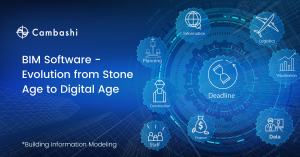New research data from Cambashi reveals that digital transformation in the construction industry is accelerating the demand for BIM software. Cambashi’s latest BIM Observatory research data indicates that, while the construction industry’s use of software could be described as being in the ‘Stone Age’ compared with manufacturing’s deployment of digital engineering software, evolution is definitely driving BIM software uptake. “Remote working trends resulting from the global pandemic, as well as government initiatives and regulations, are driving digital transformation in the construction industry,” said Petra Gartzen, Lead Analyst, Cambashi. “This in turn is accelerating a growth in demand for BIM software, enabling the construction industry to evolve from the ‘Stone Age’ to the ‘Digital Age’.” She added: “Overall, we estimate that $14bn was spent on BIM software in 2021. Despite disruptions caused by the global pandemic, the market growth has remained positive at 9% in 2020 and 11% in 2021. We forecast the BIM software market to continue with double digit growth CAGR of 12%, reaching $21bn by 2025.” Cambashi’s research data incorporates three categories of BIM:• BIM Design, which includes software used in the design stage of building and infrastructure projects. This includes five sub-segments – architectural design, structural engineering, civil engineering, MEP (mechanical, electrical and plumbing) and plant design.• BIM Construct, which covers software for collaboration on planning and building, such as data management, estimating and costing.• BIM Operate, which includes software for facilities management. According to Cambashi’s Employment dataset, currently around 200 million people work in a BIM-related profession, incorporating architecture and design, civil engineering and structural engineering services, as well as building owners/operators. Key trends covered by the research include Building Digital Twin/IIoT (Industrial Internet of Things), Simulation and off-site manufacturing of prefabricated buildings. Visit the Cambashi website to download “BIM – evolution from Stone Age to Digital Age” 2022 Research Paper.





